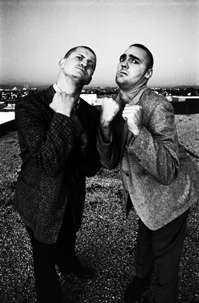The Kipper Kids
| The Kipper Kids | |
|---|---|
 The Kipper Kids--von Haselberg (left) and Routh (right) | |
| Born |
Martin Rochus Sebastian von Haselberg Brian Routh January 20, 1949 (von Haselberg) 9 March 1948 (Routh) Buenos Aires, Argentina (von Haselberg) Gateshead, County Durham, England (Routh) |
| Occupation | Contemporary artists |
| Spouse(s) |
Bette Midler (von Haselberg) Patricia Routh (née Wells) (Routh) |
| Children | Sophie Von Haselberg (Midler and von Haselberg) |
The Kipper Kids (Martin Rochus Sebastian von Haselberg, born January 20, 1949 and Brian Routh, born 9 March 1948) are contemporary artists who live and work in New York, US, and Leicester, UK.[1][2]
Biography
Martin von Haselberg and Brian Routh are a performance duo. They met in 1970 at East 15 Acting School. After months of improvisation they invented a character they called Harry Kipper and began experimenting with different theatrical formats to use him in. Upon being expelled for being "too experimental" they took to the road, touring constantly.[1] In 1974 David Ross, later director of the Whitney Museum of Art and the San Francisco Museum of Modern Art saw them in performance at Gallerie Rudolf Zwirner in Cologne and invited them to do some shows in California.[3] Despite having studiously avoided being part of a movement, they found themselves associated with the early years of punk in Los Angeles.[2] Most of their performance work, however, took place in Europe.[1]
In 1982 they stopped actively collaborating, performing as The Kipper Kids only occasionally.
Routh was married to net.art pioneer Nina Sobell from 1975-1981.[4] From 1981–87 he was married to performance artist Karen Finley.[1] Routh married digital artist, Patricia Wells in 2012. von Haselberg has been married to Bette Midler since 1984.[5]
Performance artists

Quoting from an announcement for the Berkeley Art Museum: "Through actions that at times stress the visual, and the violent aspects of social rituals, the British Team of Harry and Harry Kipper perform in a fashion that combines the zany theatrics of Spike Milligan with a scatological slapstick that is all their own". Routh and von Haselberg created elaborate but purposely low-tech installations in which they would perform "ceremonies" using mostly found objects. Examples are "Tea Ceremony" (1972) a Japanese tea ceremony-inspired piece and "Boxing Ceremony" (1972) in which one performer beats himself until bloodied whilst the other acts as referee. Japanese rituals, English music hall, Viennese Actionism, and the work of Samuel Beckett were amongst their influences.[6]
The Kipper Kids made two projects for television. For HBO they produced Mum's Magic Mulch, and for Cinemax, K.O. Kippers,[5][7] while the Kids also appeared in a 1982 project for HBO executive produced by von Haselberg, The Mondo Beyondo Show, a one-off variety show of sorts for performance artists (including a pre-Stomp Yes/No People, La La La Human Steps, Bill Irwin, Paul Zaloom and others) hosted by Bette Midler's Mondo Beyondo character. Von Haselberg made a number of films at American Film Institute with Routh in the lead role: Quiet Lives (1991), People Are No Damn Good (1991) and Your Turn To Roll It #54 (1992).[5] They also were seen as characters in the 1980 film Forbidden Zone and the 1989 film UHF. Another television appearance came during the fifth season of ABC's Moonlighting. First aired on Valentine's Day, 1989, "I See England, I See France, I See Maddie's Netherworld" featured The Kipper Kids as a pair of gravediggers in a surreal dream sequence, along with leading cast members Cybill Shepherd and Bruce Willis. The Kipper Kids also performed a song in the 1991 comedy film The Addams Family — "Playmates" which can be heard in the film and on its soundtrack.[5][7] They also starred in the 1990 comedy film The Spirit of '76.
Currently Martin von Haselberg has created a series of large photographic images made into inflatable sculptural shapes titled 'Floatulents',[8] and Brian Routh is working on soundworks that incorporate vocal soundbites of world leaders, politicians, madmen, poets, murderers and others.
References
- 1 2 3 4 On Edge: Performance at the End of the Twentieth Century; Carr, C.
- 1 2 California Video: Artists and Histories; Los Angeles The Getty Research Institute, The J. Paul Getty Museum, edited by Glenn Phillips.
- ↑ Matrix/Berkeley: A Changing Exhibition of Contemporary Art; University of California, Berkeley Art Museum and Pacific Film Archive, by Elizabeth Thomas with Project Projects
- ↑ Franklin Furnace & the Spirit of the Avant-Garde A History of the Future; Sant, Toni
- 1 2 3 4 Martin Von Haselberg at the Internet Movie Database
- ↑ Matrix/Berkeley: A Changing Exhibition of Contemporary Art; University of California, Berkeley Art Museum and Pacific Film Archive, by Elizabeth Thomas with Project Projects,
- 1 2 Brian Routh at the Internet Movie Database
- ↑ The Best of New Orleans, Mnemonic Devices and Floatulents, by D. Eric Bookhardt
External links
- The Kipper Kids website
- Brian Routh at the Internet Movie Database
- Martin von Haselberg at the Internet Movie Database
- Artifacts from the notorious Kipper Kids
- Collaborations with Brian Routh
- Video works of Brian Routh.
- Music by Brian Routh
- Martin von Haselberg's 'Floatulents' at the New Orleans Museum Art